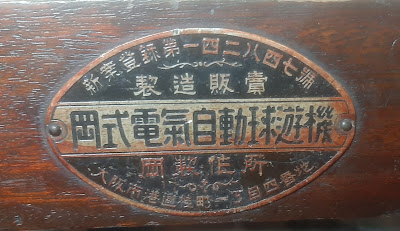| 1972 machine directory index |
The 1972 and 1973 directories list this game as being provided by セガ (Sega). I do not know if Sega added their logo, but it is safe to assume they were distributing it in Japan.
| 1972 machine directory index |
The year of this game was confirmed to me by someone with experience at Sega. I had seen it in a Sega catalogue that was printed around 1975, but I had never found any confirmation before.
This game does not appear in any of the machine directories, nor have I ever seen any magazines advertisements for it.
In November 1974, the game Duck Shooting was released by US Billiards at the MOA show.
 |
| Cash Box magazine 1974-11-09 |
 |
| Cash Box magazine 1974-11-16 |
We can see the graphics were copied, but done in a slight stylistic variation.
 |
| 1974 Duck Shooting by US Billiards |
 |
| 1975 Duck Shoot by Sega |
I have received confirmation from someone who worked at Sega that 3-Way Bingo was released in 1973. Prior to this source, this information was not publicly known. (to the best of my knowledge)
I am happy to share the information.
The playfield for 3-Way Bingo follows a template made popular in Europe in the 1960s. The playfield is almost identical to Big Strike Bowling, a very simple machine that was popular across Europe.
 |
| Big Strike Bowling (by NSM, 1960s) |
Taito began importing and rebranding these machine around 1971. Please see: 1971 Big Strike Bowling - ビッグ・ストライク・ボウリング by 太東貿易 (Taito Trading)
The hardware for 3-Way Bingo is a bit more advanced than Big Strike Bowling, which is mostly mechanical except for the lights, the ball release solenoid, and I think it also has a replay circuit.
3-Way Bingo gives you 3 shots, and a prize is paid out for any line of 3, or for lighting 3 of the 4 corners.
 |
| lit bingo card |
 |
| Bingo by Jamieson |
In the 40th Anniversary Taito book there is a list of machines, sorted by date. the list from 1972 includes Safari, but for the longest time I was unable to find any reference to Safari existing. For a while, I thought it was a reference to Taito's Safari Rifle Range, but I was wrong. Thank you to KT2 for your assistance.
 |
| mention of: サファリー (Safari) |
In 1977 Taito would release a videogame called Safari. Note that it uses the same side-art, but a number of games from that era also used the exact same side art.
 |
| 1977 Safari by タイトー (Taito) |
In 1980 Taito would release a roulette game called Safari:
 |
| 1980 Safari - サファリ by タイトー (Taito) |
We can see Home Run in two different videos, both found by TOO_yoshikawa.
 |
| ザ・ガードマン (The Guard Man) episode 118 大泥棒一家 There are two copies of Home Run on the left. This is from 1967. |
This next screenshot is from 喜劇 初詣列車 (Kigeki hatsumoude resha, 1968)
 |
| shared by TOO_yoshikawa |
This is one the earliest pachinko machines. When a winning hole was hit, the ball would hit a lever and trigger a bell that was attached to a battery. The operator would pay out the prize through a slot / cup at the bottom.
 |
| rear view of machine |
Oka are famous for making early pachinko machines, their oldest around 1929. They are not the first to make pachinko machines, that would be ON Shokai. There are no known existing copies of those machines, so currently the oldest known existing pachinko machine is by Oka.
 |
| Oka company plaque. Despite it saying "electric", only some of their machines used electricity. |
The first pachinko machines operated on sen coins. The earliest machines would have their wins paid by hand by the operator who would place coins in a bottom tray. This is one of the early machines designed to automatically pay you coins for a win. Pachinko machines would be changed to dispense balls around 1937, due to money gambling machines being prohibited by regulations.
Kazuo Sugiyama of the Birth Of Pachinko Museum says this machine was probably made between 1930 and 1932.
 |
| back of machine |
eremeka search tool // エレメカ検索ツール begin browsing at the beginning / 最初から閲覧を開始する begin browsing at 1960 / 1960年代から閲覧する begin browsing at 1970...
